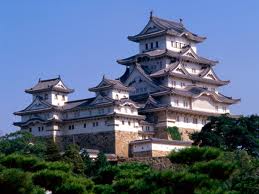Japan is one of the country in East Asia , which known to all over the world for its electronic and automotive products. Japan is also well known for its tourism.When we discus about tourism in Japan we will refer to the main symbol of Japan, Mount Fuji. Yes it is undeniable that Mount Fuji has become symbol of japan tourism but there is a lot of great things we can find in Japan. Actually beside the great nature , Japan also has an interesting art and culture. We can recognize the example of the interesting and unique culture from the magnificient architecture art of Japan, Himeji Castle. It was registered as the first Japanese world cultural heritage by UNESCO along with Horyuji Temple in December, 1993;
The Himeji Castle is located in Himeji City in the western Hyogo. It was built in the mid-14th century, and it rebuilt and renovated many times by Japanese ruler at that moment . Its figure was likened as a white heron spreading its wings, and thus called White Heron Castle. It was designated as a national treasure in 1931, and as the World Cultural Heritage in 1993.
The main complex, which consists of one main tower (donjon) and three secondary ones, is located on two hills. The main donjon ,which rises six storeys from a massive stone is connected by corridors and passages (wateriyagura) to the other three , forming an inner court. At the base of the main donjon once stood a palace, which was later destroyed by fire. It is strengthened by two wood columns that run from the fifteen meter stone foundation to the roof. The eastern and western donjon consists of four floors, three of which are visible. The northwestern tower has five floors, only three of which are visible from outside. Guarding to this central compound (Hommaru) are a number of twisting gates, walls , and subsidiary towers that posed a daunting obstacle to any attackers.
The castle grounds are divided into an inner walled zone(Ninnomaru) and a outer walled zone (Sannomaru) surrounded by a double moat. The donjon complex which forms the nucleus of the castle is situated at the highest location in the center of the inner walled zone. From farway the roofline architecture of its tower resemble a flock of herons in flight, suggesting the castle’s name Shirasagi-jo or White Heron Castle.
The Himeji Castle is located in Himeji City in the western Hyogo. It was built in the mid-14th century, and it rebuilt and renovated many times by Japanese ruler at that moment . Its figure was likened as a white heron spreading its wings, and thus called White Heron Castle. It was designated as a national treasure in 1931, and as the World Cultural Heritage in 1993.
The main complex, which consists of one main tower (donjon) and three secondary ones, is located on two hills. The main donjon ,which rises six storeys from a massive stone is connected by corridors and passages (wateriyagura) to the other three , forming an inner court. At the base of the main donjon once stood a palace, which was later destroyed by fire. It is strengthened by two wood columns that run from the fifteen meter stone foundation to the roof. The eastern and western donjon consists of four floors, three of which are visible. The northwestern tower has five floors, only three of which are visible from outside. Guarding to this central compound (Hommaru) are a number of twisting gates, walls , and subsidiary towers that posed a daunting obstacle to any attackers.
The castle grounds are divided into an inner walled zone(Ninnomaru) and a outer walled zone (Sannomaru) surrounded by a double moat. The donjon complex which forms the nucleus of the castle is situated at the highest location in the center of the inner walled zone. From farway the roofline architecture of its tower resemble a flock of herons in flight, suggesting the castle’s name Shirasagi-jo or White Heron Castle.


No comments:
Post a Comment